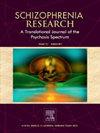Altered neural oscillations are associated with improved working memory performance in schizophrenia following D-cycloserine administration
IF 3.6
2区 医学
Q1 PSYCHIATRY
引用次数: 0
Abstract
Cognitive deficits, such as impaired working memory, are a core feature of schizophrenia and a key target for intervention that have been hypothesized to reflect hypofunction at the N-methyl-d-aspartate glutamate receptor (NMDAR). Working memory depends on neural oscillations in the gamma (30–80 Hz), theta (4–7 Hz), and alpha (8–13 Hz) frequency bands, with gamma oscillations known to be strongly impacted in schizophrenia and to be sensitive to NMDAR hypofunction. Importantly, in a previous double-blind randomized placebo-controlled study, findings suggested that n-back working memory performance was improved in schizophrenia patients who received 100 mg of the NMDAR agonist D-cycloserine (SZ-DCS; n = 17) compared to patients who received placebo (SZ-placebo; n = 16; Forsyth et al., 2017). To understand potential mechanisms underlying this effect, the current study examined electroencephalogram data collected during this study to identify whether gamma, theta, and alpha oscillations were altered in patients who received DCS versus placebo. Results revealed reduced working memory-related gamma power in right frontal and occipital channels from 1 to 1.5 s post-stimulus onset in SZ-DCS versus SZ-placebo patients. SZ-DCS patients also showed reduced frontal theta power relative to SZ-placebo patients across memory loads. Conversely, SZ-DCS patients showed increased left-hemisphere alpha power during the 0-back control condition, without differences during working memory loads. Our findings suggest that increasing NMDAR signaling in schizophrenia may improve working memory performance by increasing the efficiency of gamma and theta oscillations that support working memory demands, as well as enhancing alpha oscillations that support preparatory attentional processes.
精神分裂症患者服用d -环丝氨酸后,神经振荡的改变与工作记忆表现的改善有关
认知缺陷,如工作记忆受损,是精神分裂症的核心特征,也是干预的关键目标,据推测,这反映了n -甲基-d-天冬氨酸谷氨酸受体(NMDAR)功能低下。工作记忆依赖于伽马(30 - 80hz)、θ (4 - 7hz)和α (8 - 13hz)频段的神经振荡,已知伽马振荡在精神分裂症中受到强烈影响,并且对NMDAR功能减退很敏感。重要的是,在之前的一项双盲随机安慰剂对照研究中,研究结果表明,接受100毫克NMDAR激动剂d -环丝氨酸(SZ-DCS;n = 17)与接受安慰剂的患者(sz -安慰剂;n = 16;Forsyth等人,2017)。为了了解这种效应的潜在机制,本研究检查了在研究期间收集的脑电图数据,以确定接受DCS与安慰剂治疗的患者的伽马、θ和α振荡是否发生了改变。结果显示,与安慰剂相比,SZ-DCS患者在刺激后1 ~ 1.5 s右脑额叶和枕叶通道的工作记忆相关伽马功率降低。在记忆负荷方面,SZ-DCS患者的额波功率也比sz -安慰剂患者低。相反,SZ-DCS患者在0-back对照条件下左半球α功率增加,在工作记忆负荷下无差异。我们的研究结果表明,精神分裂症患者NMDAR信号的增加可能会通过提高支持工作记忆需求的伽马和θ振荡的效率,以及增强支持准备注意过程的α振荡的效率来改善工作记忆的表现。
本文章由计算机程序翻译,如有差异,请以英文原文为准。
求助全文
约1分钟内获得全文
求助全文
来源期刊

Schizophrenia Research
医学-精神病学
CiteScore
7.50
自引率
8.90%
发文量
429
审稿时长
10.2 weeks
期刊介绍:
As official journal of the Schizophrenia International Research Society (SIRS) Schizophrenia Research is THE journal of choice for international researchers and clinicians to share their work with the global schizophrenia research community. More than 6000 institutes have online or print (or both) access to this journal - the largest specialist journal in the field, with the largest readership!
Schizophrenia Research''s time to first decision is as fast as 6 weeks and its publishing speed is as fast as 4 weeks until online publication (corrected proof/Article in Press) after acceptance and 14 weeks from acceptance until publication in a printed issue.
The journal publishes novel papers that really contribute to understanding the biology and treatment of schizophrenic disorders; Schizophrenia Research brings together biological, clinical and psychological research in order to stimulate the synthesis of findings from all disciplines involved in improving patient outcomes in schizophrenia.
 求助内容:
求助内容: 应助结果提醒方式:
应助结果提醒方式:


